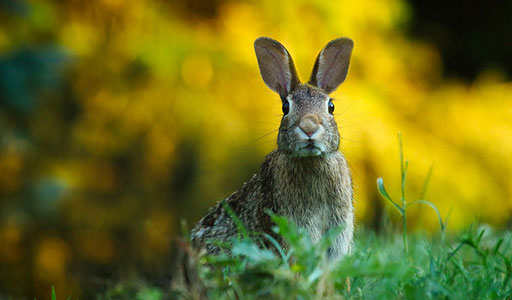Rabbit Removal
Do you need to get rid of rabbits? We can help!

Rabbit Removal Strategies
If you have noticed bites taken out of your plants and vegetation, you might have a cottontail rabbit in your yard. The cottontail rabbit prefers habitats between woody areas and open land. If your yard has abundant cover interspersed with open areas, you have an ideal rabbit habitat.
Don’t waste your time and energy creating elaborate DIY rabbit traps that won’t work. Instead, call in a team of experts at Trutech to conduct rabbit removal and rabbit control services for a quick, effective solution. Other rabbit removal methods that you purchase on your own are only a short term solution. Hiring a professional from Trutech for your rabbit control needs takes care of the problem, sanitizing your home after trapping the creature.
Trust Trutech to take care of all of your rabbit removal needs in the most efficient, humane, and environmentally sensitive manner. There is no reason to wait until rabbits destroy your yard to handle your animal prevention, control, and removal needs. Reach out to Trutech today to implement our environmentally sound rabbit control solutions to keep your yard and home safe for all of its invited inhabitants!
Hear what a Rabbit sounds like
Rabbit Problem

Signs a Rabbit is on Your Property
Rabbits are greyish-brown mammals with long ears and short bushy tails. Eastern cottontail rabbits inhabit most of the central and eastern United States. Rabbits inhabit vegetative areas that offer plenty of grass and plants for them to feed on. Rabbits are most active during the early morning and around sunset. Female rabbits can even produce up to 6 litters per year. Rabbits are also known to carry various diseases that can be harmful if they are transferred to humans or animals.

Dangers of Rabbit Infestation
When rabbits invade yards and gardens, they can be highly destructive to the plant life in the area. Rabbits feed on vegetation such as grasses, flowers, herbs, and stems. They also love common garden crops. During the winter, when vegetation is scarce or snow-covered, rabbits eat the bark of trees and shrubs, which affects the foliage in places like orchards, parks, and landscaped yards.
Humane Rabbit Removal & Control Strategies

Entry into property
Due to their feeding habits and habitat requirements, rabbits are frequent invaders of yards and other outdoor areas that humans regularly try to keep pest-free. Gardens, agricultural fields and farmlands, parks, and residential lawns all provide vegetation for rabbits to eat and plenty of places for the timid animals to take cover from predators. Although they respond to threats by fleeing rapidly, rabbits can adapt to living near humans and even reside on the fringes of commercially developed properties, such as golf courses and airports.

Trapping & Removal
Successful rabbit removal can be difficult to achieve without professional assistance, as the pests reproduce rapidly and develop quickly from birth to sexual maturity. Furthermore, simply trapping and removing individual specimens only encourages rabbits from other areas to move in and fill the void. The best way to handle rabbit problems safely, effectively, and lawfully is by enlisting the services of a trained pest control professional.

Prevention & Exclusion
Proper rabbit prevention involves the implementation of exclusion methods such as fencing and trunk guards. Fences keep rabbits out of gardens and away from crops, while trunk guards prevent the pests from gnawing on tree bark. Rabbits can also be deterred from invading an otherwise attractive area with the removal of any thickets, tall grasses, or shrubs that might provide cover.
Frequently Asked Questions
Rabbit holes and burrows typically have much of their fur nearby. Rabbits will shed and use their fur to make a soft nesting area for their babies. The holes are usually baseball- to softball-sized. If the hole is larger, more like a volleyball or basketball, it is a groundhog hole.
While most homeowners consider rabbits pests because they eat garden plants, their ability to spread disease is also cause for concern. Tularemia is the most common rabbit disease.
Hunting season puts people at the highest risk for tularemia. Touching infected animals and eating undercooked meat are the most common ways for the illness to spread. Symptoms of this rabbit disease can start within three days after contact and include:
- Skin ulcers
- Swollen lymph nodes
- Sore throat
- Sudden fever or chills
- Muscle aches
Rabbits in garages cause plenty of issues by chewing on wiring and damaging expensive lawn care tools and even motor vehicles. Since they aren’t likely to stay in the confines of a garage, rabbits also cause destruction to the surrounding property by consuming garden crops and other foliage.
When grass and leaves are in short supply, rabbits strip the bark from sprouts and seedlings, stunting their growth. More seriously, accumulations of rabbit urine and feces can contribute to the spread of disease and make for unsanitary conditions.
Wild rabbits mostly eat vegetation and nest on the edges of wooded areas and thickets in suburban neighborhoods. As these habitats are often located in close proximity to private properties, the pests are able to walk onto lawns and pilfer vegetables and flowers from gardens. Flowerbeds provide them with steady access to food and are easily accessible, which makes infestations of rabbits in gardens common.
In order to properly protect gardens from rabbits, there are several exclusion and removal options you can seek. Wire guards around tree trunks in addition to fencing around gardens can effectively keep the pests from eating vegetation. Removing brush piles and other forms of cover also helps keep rabbits from nesting on private properties. Of course, the only sure method of control is contacting a professional wildlife removal service. The trained specialists at Trutech can safely and legally remove rabbits in gardens.
Rabbits can enter homes but usually do so by mistake. Not known as good climbers, they are typically found at the ground floor, in garages and basements, and under foundations. In rare cases, rabbits could be found in the attic. More often than not, however, it is probably another pest animal.
Squirrels, rats, and mice are all expert climbers and can regularly be found in attics, making nests and causing damage. Homeowners unfamiliar with local pests could mistake one of these animals for rabbits in the attic.
Areas under homes provide ideal denning sites for pesky rabbits. They can create extensive burrows under houses and similar structures. Commonly residing in residential areas with rich vegetation, rabbits under the house construct their nests in locations where they are protected from predators, can find ample food, and can hide their young. The abandoned burrows of other animals are also frequently used and can lead rabbits underneath homes.
Getting rid of rabbits under the house often requires the services of a trained wildlife removal expert. Rabbits are rampant breeders that leave their young in their nests under homes, which becomes problematic when attempting removal. The wildlife professionals at Trutech will make sure that baby rabbits are not left underneath foundations, decks, or sheds when removing adults. They will humanely trap and remove any rabbits under the house and help prevent the future return of the pesky critters.


